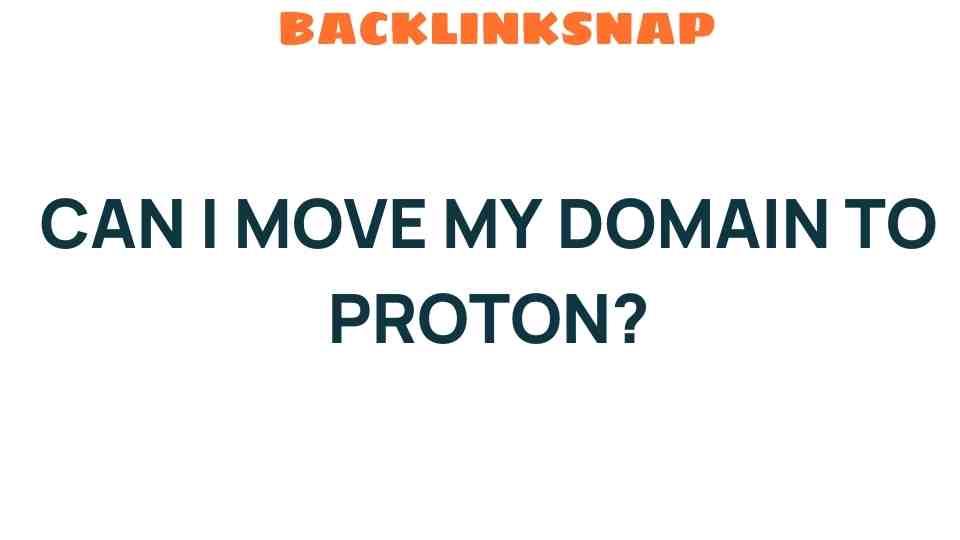Can I Move My Domain to Proton? A Comprehensive Guide to Domain Migration
In today’s digital landscape, the importance of secure communication and digital privacy cannot be overstated. Many individuals and businesses are seeking reliable platforms to manage their online presence and communications, leading to an increased interest in **Proton Mail** and its associated services. If you’re considering a domain transfer to Proton, this comprehensive guide will walk you through the process, highlight the benefits, and address common concerns related to domain migration.
Understanding the Basics of Domain Transfer
Before diving into the specifics of moving your domain to Proton, it’s essential to understand what a domain transfer entails. A domain transfer is the process of moving your domain name from one registrar to another. This can be necessary for a variety of reasons, including better pricing, improved services, or enhanced security features. Proton Mail offers a suite of services that prioritize email security and digital privacy, making it an attractive option for many users.
Why Choose Proton for Your Domain Migration?
Proton is well-known for its commitment to user privacy and security. Here are several compelling reasons to consider Proton for your domain migration:
- Email Security: Proton Mail utilizes end-to-end encryption, ensuring that only you and your intended recipients can read your messages. This level of security is crucial for protecting sensitive information.
- Digital Privacy: With Proton, your data is never sold to third parties. Their strict privacy policies align with the needs of users who value confidentiality.
- Proton Services: Beyond just email, Proton offers a range of services, including secure file storage and calendar, all designed with privacy in mind.
- User-Friendly Interface: The Proton platform is designed to be intuitive, making it easy for users to manage their domains and email accounts.
- Reliable Customer Support: Proton provides robust support to assist users during the migration process and beyond.
Steps for Domain Migration to Proton
Now that you’re convinced of the merits of Proton, let’s walk through the steps you need to take to successfully transfer your domain.
1. Prepare Your Domain for Transfer
Before initiating a domain transfer, ensure your domain is eligible. Here are a few preparatory steps:
- Check if your domain is locked. Most registrars offer a locking feature to prevent unauthorized transfers. You’ll need to unlock it.
- Obtain the Authorization Code (EPP code) from your current registrar. This code is crucial for confirming your ownership of the domain.
- Verify that your domain has been registered for more than 60 days. If it’s less than that, you may not be able to transfer it.
2. Create a Proton Account
If you haven’t already, you’ll need to create an account with Proton. As part of this process, choose a suitable plan that meets your needs, whether it’s for personal use or a business.
3. Initiate the Transfer
Once your domain is ready, log in to your Proton account and navigate to the domain settings. Look for the option to initiate a domain migration or transfer. Enter the Authorization Code when prompted, and follow the on-screen instructions.
4. Confirm the Transfer
After initiating the transfer, you will likely receive an email from your current registrar asking you to confirm the transfer. Follow the instructions provided to approve the transfer.
5. Wait for the Transfer to Complete
Domain transfers can take anywhere from a few hours to several days, depending on the registrars involved. During this time, you can still use your email and website as normal.
6. Update DNS Settings
After the transfer is complete, ensure that your DNS settings are updated to point to Proton’s servers. This step is essential for maintaining your website and email services.
Post-Transfer Considerations
After successfully moving your domain to Proton, there are a few additional steps you should consider:
- Review Email Settings: Verify that your email settings are correctly configured. Proton provides detailed guides to assist with this.
- Enable Two-Factor Authentication: For an added layer of security, activate two-factor authentication on your Proton account.
- Monitor Your Domain: Keep an eye on your domain’s performance and security settings to ensure everything runs smoothly.
Frequently Asked Questions
1. Can I transfer my domain if it’s currently registered with another provider?
Yes, as long as your domain is unlocked and you have the Authorization Code, you can transfer it to Proton.
2. How long does a domain transfer take?
Transfers typically take between 5 to 7 days, but it can vary based on the registrars involved.
3. Will my website go down during the transfer?
No, your website and email services should remain operational throughout the transfer process.
4. What happens to my emails during the transfer?
Your existing emails will remain intact. However, ensure you back up any important data just to be safe.
5. Is Proton Mail really secure?
Yes, Proton Mail uses end-to-end encryption and has a strong focus on user privacy, making it one of the most secure email providers available.
6. Can I still use my existing email address after migrating to Proton?
Yes, you can continue using your existing email address; just make sure to set up the necessary email forwarding or migration settings within Proton.
Conclusion
In conclusion, migrating your domain to Proton is not only feasible but also a wise decision for those prioritizing email security and digital privacy. With its robust features, user-friendly interface, and a strong commitment to privacy, Proton stands out as a leading choice for individuals and businesses alike. Whether you’re looking to enhance your email security or consolidate your online services, a domain transfer to Proton can provide the peace of mind and functionality you need. Take the first step toward a more secure online presence today!
For more information on Proton services, visit their official site here.
To explore further resources on domain management and digital privacy, check out the Electronic Frontier Foundation.
This article is in the category Digital Marketing and created by BacklinkSnap Team




